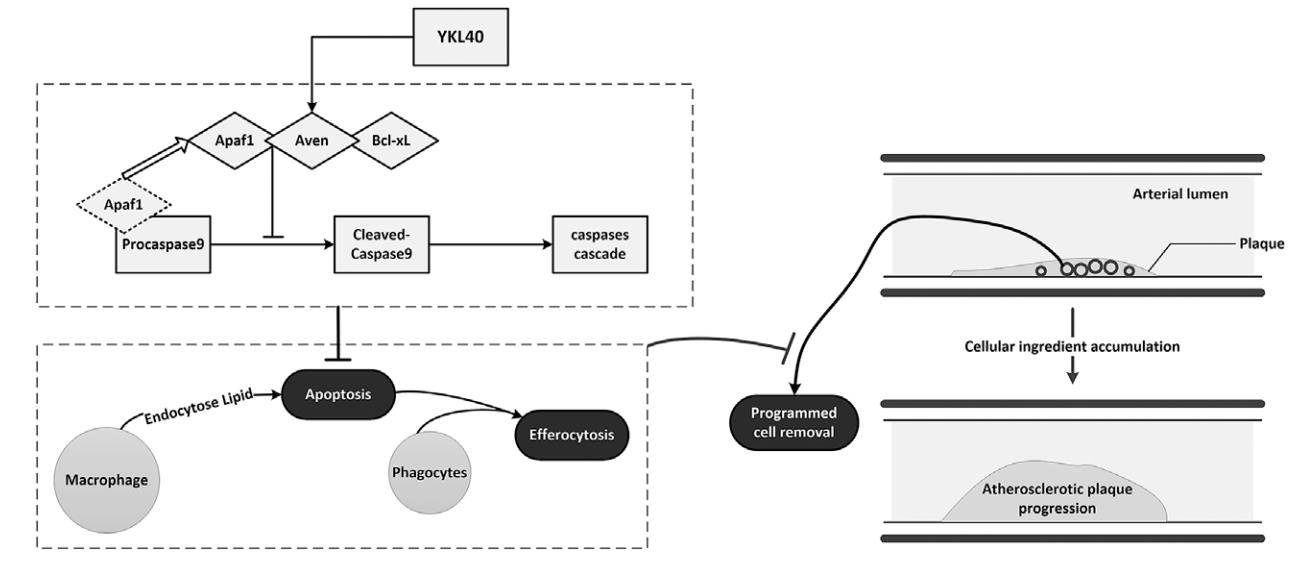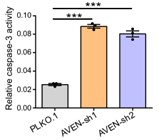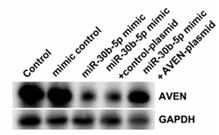AVEN
-
Official Full Name
apoptosis, caspase activation inhibitor -
Overview
Apoptosis plays a major role in normal organism development, tissue homeostasis, and removal of damaged cells. Disruption of this process has been implicated in a variety of diseases such as cancer. AVEN is a recently discovered protein that blocks apoptosis induced by Apaf-1 and caspase-9. It is thought that AVEN functions by binding to Bcl-xL, an antiapoptotic member of the Bcl-2 family, and to Apaf-1, possibly interfering with the ability of Apaf-1 to self-associate, suggesting that AVEN impedes Apaf-1-mediated caspase activation. Higher levels of AVEN mRNA are seen in patients with acute leukemia than in control patients, suggesting that AVEN may be useful as a prognostic indicator in leukemia patients. -
Synonyms
AVEN;apoptosis, caspase activation inhibitor;PDCD12;cell death regulator aven;programmed cell death 12;OTTHUMP00000159733
Recombinant Proteins
- Human
- Chicken
- Zebrafish
- Mouse
- HEK293
- Wheat Germ
- Mammalian Cells
- Human Cells
- In Vitro Cell Free System
- DDK
- Myc
- GST
- His
- Flag
| Cat.# | Product name | Source (Host) | Species | Tag | Protein Length | Price |
|---|---|---|---|---|---|---|
| AVEN-3034H |
Recombinant Human AVEN Protein, MYC/DDK-tagged

|
HEK293 | Human | DDK&Myc |
|
|
| AVEN-1041H | Recombinant Human AVEN protein, GST-tagged | Wheat Germ | Human | GST |
|
|
| AVEN-1249C | Recombinant Chicken AVEN | Mammalian Cells | Chicken | His |
|
|
| AVEN-4283Z | Recombinant Zebrafish AVEN | Mammalian Cells | Zebrafish | His |
|
|
| AVEN-01H | Recombinant Human AVEN Protein, DYKDDDDK-tagged | Human Cells | Human | Flag |
|
|
| AVEN-1254HF | Recombinant Full Length Human AVEN Protein, GST-tagged | In Vitro Cell Free System | Human | GST | Full L. 362 amino acids |
|
| Aven-1790M | Recombinant Mouse Aven Protein, Myc/DDK-tagged | HEK293 | Mouse | DDK&Myc |
|
|
| AVEN-3208H | Recombinant Human AVEN Protein, Myc/DDK-tagged, C13 and N15-labeled | HEK293 | Human | DDK&Myc |
|
Background
What is AVEN protein?
AVEN gene (apoptosis and caspase activation inhibitor) is a protein coding gene which situated on the long arm of chromosome 15 at locus 15q14. AVEN is a protein that plays a crucial role in inhibiting apoptosis and promoting cell survival. It is known to bind to anti-apoptotic Bcl-2 family proteins and inhibit the activation of caspases, which are enzymes involved in the execution of apoptosis. AVEN has been identified as an important regulator in the intrinsic pathway of apoptosis and is implicated in various cellular processes, including cell cycle regulation and response to DNA damage. Its overexpression is associated with poor prognosis in several types of cancer, suggesting that it may have oncogenic properties by contributing to tumor cell survival and resistance to chemotherapy. The AVEN protein is consisted of 362 amino acids and AVEN molecular weight is approximately 38.5 kDa.
What is the function of AVEN protein?
AVEN is a protein coding gene that plays a significant role in inhibiting apoptosis, which is the process of programmed cell death. It has been associated with various diseases, including certain types of cancers such as leukemia, and is implicated in the intrinsic pathway for apoptosis. AVEN functions as an oncoprotein in hematopoietic neoplasms, suggesting its role in promoting the survival of cancer cells. Furthermore, AVEN can act as an activator of the ATM protein, which is involved in the DNA damage response and cell cycle regulation, particularly inhibiting G2/M progression.

Fig1. Schematic diagram of the mechanism of YKL-40 aggravates early-stage atherosclerosis by inhibiting macrophage apoptosis in an Aven-dependent way. (Wei Huan, 2021)
AVEN Related Signaling Pathway
AVEN binds to anti-apoptotic proteins from the Bcl-2 family and inhibits the activation of caspases, which are central regulatory molecules of apoptosis. AVEN can act as an activator of ATM kinase to inhibit G2/M phase progression after DNA damage. In addition, AVEN may be involved in the regulation of signaling networks related to T cell activation and functional programming, and may be involved in the interactive regulation of interferon and inflammatory signaling pathways. AVEN expression in lung adenocarcarcinoma is associated with tumor progression and survival in patients, and is associated with changes in immune invasion.
AVEN Related Diseases
In summary, the AVEN protein is implicated in a variety of diseases, particularly in the development and progression of cancers. Its overexpression is associated with adverse clinical outcomes and poor prognosis in Acute Myeloid Leukemia (AML), and targeting AVEN can enhance the sensitivity to apoptosis and the efficacy of chemotherapy, indicating its potential as a therapeutic target. Furthermore, AVEN's role in lung adenocarcinoma (LUAD) has been studied, where its high expression correlates with tumor progression and shorter patient survival, as well as changes in immune infiltration. Additionally, diseases related to AVEN include rare disorders such as congenital ichthyosis, autosomal recessive disease type 5, and schizotypal personality disorder.
Bioapplications of AVEN
Given its overexpression in various cancers and its association with poor prognosis, AVEN is a potential therapeutic target and biomarker for cancer diagnosis and treatment. AVEN's involvement in germ cell development highlights its importance in studies of reproductive biology. AVEN's potential role in immune cell regulation and its involvement in the immune response to various stimuli make it a subject of interest in immunological research. AVEN's function as an activator of the ATM kinase in the DNA damage response pathway positions it as a candidate for research into cell cycle control and genomic stability.
Case Study
Case Study 1: Peng Yu, 2023
Myocardial infarction (MI) is a leading cause of heart failure (HF), associated with morbidity and mortality worldwide. As an essential part of gene expression regulation, the role of alternative polyadenylation (APA) in post-MI HF remains elusive. Here, researchers revealed a global, APA-mediated, 3' untranslated region (3' UTR)-lengthening pattern in both human and murine post-MI HF samples. Furthermore, the 3' UTR of apoptotic repressor gene, AVEN, is lengthened after MI, contributing to its downregulation. AVEN knockdown increased cardiomyocyte apoptosis, whereas restoration of AVEN expression substantially improved cardiac function. Mechanistically, AVEN 3' UTR lengthening provides additional binding sites for miR-30b-5p and miR-30c-5p, thus reducing AVEN expression. Additionally, PABPN1 (poly(A)-binding protein 1) was identified as a potential regulator of AVEN 3' UTR lengthening after MI.

Fig1. Western blot of AVEN expression in control and ICM samples.

Fig2. Caspase-3 activity indicating apoptosis after AVEN knockdown in AC16 cells.
Case Study 2: Tingrui Ge, 2022
This research aims to explore the role of Tanshinone IIA (Tan IIA) and microRNA (miR)-30b-5p in chemoresistance of colorectal cancer (CRC). The expression levels of miR-30b-5p and apoptosis and caspase activation inhibitor (AVEN) was detected by reverse transcription-quantitative polymerase chain reaction assay. The cell proliferation and apoptosis were examined by 3-(4,5-dimethylthiazol-2-yl)-2,5-diphenyltetrazolium bromide (MTT) and flow cytometry assays. The target relationship between miR-30b-5p and AVEN was confirmed by Dual-luciferase reporter assay. Transwell assay was performed to assess CRC cells' metastasis. Western blot was carried out to measure the apoptosis-related protein. The results showed that miR-30b-5p was lowly expressed in oxaliplatin-resistance CRC cells SW480 (SW480/R) compared to SW480 cells. Overexpression of miR-30b-5p significantly suppressed the malignant biological behaviors of SW480/R cells and significantly promoted the sensitivity of SW480/R cells to oxaliplatin by down-regulated AVEN expression.

Fig3. The dual-luciferase gene reporter assay was completed to confirm the direct binding relationship between miR-30b-5p and AVEN.

Fig4. Western blot was performed to assess AVEN levels.
Quality Guarantee
High Purity
.jpg)
Fig1. SDS-PAGE (AVEN-1041H)
.
.jpg)
Fig2. SDS-PAGE (AVEN-3208H)
Involved Pathway
AVEN involved in several pathways and played different roles in them. We selected most pathways AVEN participated on our site, such as , which may be useful for your reference. Also, other proteins which involved in the same pathway with AVEN were listed below. Creative BioMart supplied nearly all the proteins listed, you can search them on our site.
| Pathway Name | Pathway Related Protein |
|---|
Protein Function
AVEN has several biochemical functions, for example, . Some of the functions are cooperated with other proteins, some of the functions could acted by AVEN itself. We selected most functions AVEN had, and list some proteins which have the same functions with AVEN. You can find most of the proteins on our site.
| Function | Related Protein |
|---|
Interacting Protein
AVEN has direct interactions with proteins and molecules. Those interactions were detected by several methods such as yeast two hybrid, co-IP, pull-down and so on. We selected proteins and molecules interacted with AVEN here. Most of them are supplied by our site. Hope this information will be useful for your research of AVEN.
Resources
Related Services
Related Products
References
- Potty, ASR; Xenopoulos, A; et al. The Effect of Antiapoptosis Genes on Clarification Performance. BIOTECHNOLOGY PROGRESS 30:100-107(2014).
- Ha, TK; Jeon, MK; et al. Effect of Bcl-x(L) Overexpression on Lactate Metabolism in Chinese Hamster Ovary Cells Producing Antibody. BIOTECHNOLOGY PROGRESS 29:1594-1598(2013).


